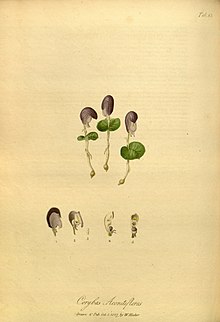Corybas aconitiflorus
| Corybas aconitiflorus | |
|---|---|

| |
| From The Paradisus Londinensis: 1 – flower, half of the upper sepal cut away; 2 – half of the labellum showing one of the nectaries near the base; 3 – column, natural size; 4,5 – side and front view of the column magnified | |
| Scientific classification | |
| Kingdom: | Plantae |
| Clade: | Tracheophytes |
| Clade: | Angiosperms |
| Clade: | Monocots |
| Order: | Asparagales |
| Family: | Orchidaceae |
| Subfamily: | Orchidoideae |
| Tribe: | Diurideae |
| Genus: | Corybas |
| Species: | C. aconitiflorus
|
| Binomial name | |
| Corybas aconitiflorus | |
Corybas aconitiflorus is a species of terrestrial orchid native to eastern Australia, from south-east Queensland to Tasmania.[1] The small flowers have a hooded appearance as the uppermost sepal hides most of the rest of the flower. It is the type species of the genus Corybas.
Description
Corybas aconitiflorus grows from a pair of small tubers, to which it dies down in the dormant season. The stems are short and upright, with generally a single flat, smooth, basal leaf. The single flower is small. The hooded uppermost (dorsal) sepal covers and hides most of the rest of the flower. The remaining sepals and the lateral petals are similar in appearance. The lower petal, the lip or labellum, is much smaller than the other petals and sepals. It is undivided with its margins turned inwards. The thin column is wider at the base and has fused wings along its body. There are terminal persistent pollen masses (pollinia), cream in colour, are fixed directly to the viscidia (sticky pads which adhere to pollinators). Little is known about the pollination mechanism of this species, because the flower is hidden by the dorsal sepal and the species is difficult to cultivate.[2]
Taxonomy
Corybas aconitiflorus was first described by Richard Salisbury in The Paradisus Londinensis in 1807,[1] where it was illustrated by William Hooker.[3] This was also the source of the genus name Corybas. Both the genus name and the specific epithet refer to the shape of the flower. Corybas is derived from the Greek κορύβαντος (korybantos),[3] a male dancer who worshipped the goddess Cybele, shown in illustrations wearing a crested helmet. The specific epithet aconitiflorus means "with a flower like Aconitum (monkshood)".
In 2002, Clements and Jones proposed splitting Corybas into many smaller genera. However, because Corybas aconitiflorus is the type species of the genus, it will remain in Corybas.[4]
References
- ^ a b c "Corybas actonitiflorus", World Checklist of Selected Plant Families, Royal Botanic Gardens, Kew, retrieved 2013-09-24
- ^ Jones, David (2001), "Corybas", in Pridgeon, A.M.; Cribb, P.J.; Chase, M.W.; Rasmussen, F.N. (eds.), Genera Orchidacearum, Vol. 2 Orchidoideae, Part 1, Oxford: Oxford University Press, ISBN 978-0-19-850710-9
{{citation}}: Unknown parameter|lastauthoramp=ignored (|name-list-style=suggested) (help) - ^ a b Salisbury, R.A.; Hooker, W. (1805–1808), "83 (figure and notes)", The Paradisus Londonensis : or Coloured Figures of Plants Cultivated in the Vicinity of the Metropolis, London: W. Hooker (printer D.N. Shury), doi:10.5962/bhl.title.53520, OCLC 1864969
{{citation}}: External link in|chapterurl=|chapterurl=ignored (|chapter-url=suggested) (help); Unknown parameter|lastauthoramp=ignored (|name-list-style=suggested) (help) - ^ Jones, D.L.; et al. (2002), "Nomenclatural notes arising from studies into the tribe Diurideae (Orchidaceae)", Orchadian, 13: 436–468
